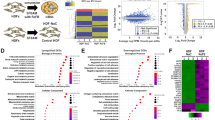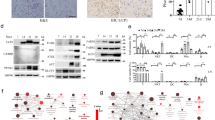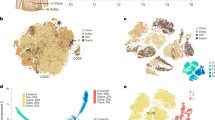Abstract
We investigated the ability of fetal mesenchymal stem cells (fMSCs) to differentiate into brown and white adipocytes and compared the expression of a number of marker genes and key regulatory factors. We showed that the expression of key adipocyte regulators and markers during differentiation is similar to that in other human and murine adipocyte models, including induction of PPARγ2 and FABP4. Notably, we found that the preadipocyte marker, Pref-1, is induced early in differentiation and then declines markedly as the process continues, suggesting that fMSCs first acquire preadipocyte characteristics as they commit to the adipogenic lineage, prior to their differentiation into mature adipocytes. After adipogenic induction, some stem cell isolates differentiated into cells resembling brown adipocytes and others into white adipocytes. Detailed investigation of one isolate showed that the novel brown fat-determining factor PRDM16 is expressed both before and after differentiation. Importantly, these cells exhibited elevated basal UCP-1 expression, which was dependent on the activity of the orphan nuclear receptor ERRα, highlighting a novel role for ERRα in human brown fat. Thus fMSCs represent a useful in vitro model for human adipogenesis, and provide opportunities to study the stages prior to commitment to the adipocyte lineage. They also offer invaluable insights into the characteristics of human brown fat.
Similar content being viewed by others
Log in or create a free account to read this content
Gain free access to this article, as well as selected content from this journal and more on nature.com
or
References
Cannon B, Nedergaard J . Brown adipose tissue: function and physiological significance. Physiol Rev 2004; 84:277–359.
Farmer SR . Transcriptional control of adipocyte formation. Cell Metab 2006; 4:263–273.
Smas CM, Sul HS . Pref-1, a protein containing EGF-like repeats, inhibits adipocyte differentiation. Cell 1993; 73:725–734.
Lee K, Villena JA, Moon YS, et al. Inhibition of adipogenesis and development of glucose intolerance by soluble preadipocyte factor-1 (Pref-1). J Clin Invest 2003; 111:453–461.
Moon YS, Smas CM, Lee K, et al. Mice lacking paternally expressed Pref-1/Dlk1 display growth retardation and accelerated adiposity. Mol Cell Biol 2002; 22:5585–5592.
Timmons JA, Wennmalm K, Larsson O, et al. Myogenic gene expression signature establishes that brown and white adipocytes originate from distinct cell lineages. Proc Natl Acad Sci USA 2007; 104:4401–4406.
Crisan M, Casteilla L, Lehr L, et al. A reservoir of brown adipocyte progenitors in human skeletal muscle. Stem Cell 2008; 26:2425–2433.
Seale P, Bjork B, Yang W, et al. PRDM16 controls a brown fat/skeletal muscle switch. Nature 2008; 454:961–967.
Seale P, Kajimura S, Yang W, et al. Transcriptional control of brown fat determination by PRDM16. Cell Metab 2007; 6:38–54.
Puigserver P, Wu Z, Park CW, et al. A cold-inducible coactivator of nuclear receptors linked to adaptive thermogenesis. Cell 1998; 92:829–839.
Leonardsson G, Steel JH, Christian M, et al. Nuclear receptor corepressor RIP140 regulates fat accumulation. Proc Natl Acad Sci USA 2004; 101:8437–8442.
Christian M, Kiskinis E, Debevec D, et al. RIP140-targeted repression of gene expression in adipocytes. Mol Cell Biol 2005; 25:9383–9391.
Morganstein DL, Christian M, Turner JJ, Parker MG, White R . Conditionally immortalized white preadipocytes: a novel adipocyte model. J Lipid Res 2008; 49:679–685.
Lelliott CJ, Medina-Gomez G, Petrovic N, et al. Ablation of PGC-1beta results in defective mitochondrial activity, thermogenesis, hepatic function, and cardiac performance. PLoS Biol 2006; 4:e369.
Pittenger MF, Mackay AM, Beck SC, et al. Multilineage potential of adult human mesenchymal stem cells. Science 1999; 284:143–147.
Mackay DL, Tesar PJ, Liang LN, Haynesworth SE . Characterizing medullary and human mesenchymal stem cell-derived adipocytes. J Cell Physiol 2006; 207:722–728.
Gemmis PD, Lapucci C, Bertelli M, et al. A real-time pcr approach to evaluate adipogenic potential of amniotic fluid-derived human mesenchymal stem cells. Stem Cell Dev 2006; 15:719–728.
Campagnoli C, Roberts IAG, Kumar S, et al. Identification of mesenchymal stem/progenitor cells in human first-trimester fetal blood, liver, and bone marrow. Blood 2001; 98:2396–2402.
Ryden M, Dicker A, Gotherstrom C, et al. Functional characterization of human mesenchymal stem cell-derived adipocytes. Biochem Biophys Res Commun 2003; 311:391–397.
Tomlinson JJ, Boudreau A, Wu D, Atlas E, Hache RJG . Modulation of early human preadipocyte differentiation by glucocorticoids. Endocrinology 2006; 147:5284–5293.
Nakamura T, Shiojima S, Hirai Y, et al. Temporal gene expression changes during adipogenesis in human mesenchymal stem cells. Biochem Biophys Res Commun 2003; 303:306–312.
Janderova L, McNeil M, Murrell AN, Mynatt RL, Smith SR . Human mesenchymal stem cells as an in vitro model for human adipogenesis. Obes Res 2003; 11:65–74.
del Mar Gonzalez-Barroso M, Pecqueur C, Gelly C, et al. Transcriptional activation of the human ucp1 gene in a rodent cell line. Synergism of retinoids, isoproterenol, and thiazolidinedione is mediated by a multipartite response element. J Biol Chem 2000; 275:31722–31732.
Busch BB, Stevens WC, Martin R, et al. Identification of a selective inverse agonist for the orphan nuclear receptor estrogen-related receptor alpha. J Med Chem 2004; 47:5593–5596.
Kozak UC . An upstream enhancer regulating brown-fat-specific expression of the mitochondrial uncoupling protein gene. Mol Cell Biol 1994; 14:59–67.
Sekiya I, Larson BL, Vuoristo JT, Cui JG, Prockop DJ . Adipogenic differentiation of human adult stem cells from bone marrow stroma (MSCs). J Bone Miner Res 2004; 19:256–264.
Hung SC, Chang CF, Ma HL, Chen TH, Low-Tone HL . Gene expression profiles of early adipogenesis in human mesenchymal stem cells. Gene 2004; 340:141–150.
Sladek R, Bader JA, Giguere V . The orphan nuclear receptor estrogen-related receptor alpha is a transcriptional regulator of the human medium-chain acyl coenzyme A dehydrogenase gene. Mol Cell Biol 1997; 17:5400–5409.
Luo J, Sladek R, Carrier J, et al. Reduced fat mass in mice lacking orphan nuclear receptor estrogen-related receptor alpha. Mol Cell Biol 2003; 23:7947–7956.
Villena JA, Hock MB, Chang WY, et al. Orphan nuclear receptor estrogen-related receptor alpha is essential for adaptive thermogenesis. Proc Natl Acad Sci USA 2007; 104:1418–1423.
Debevec D, Christian M, Morganstein D, et al. Receptor interacting protein 140 regulates expression of uncoupling protein 1 in adipocytes through specific peroxisome proliferator activated receptor isoforms and estrogen-related receptor alpha. Mol Endocrinol 2007; 21:1581–1592.
Robinson HP, Fleming JE . A critical evaluation of sonar “crown-rump length” measurements. Br J Obstet Gynaecol 1975; 82:702–710.
Ramirez-Zacarias JL, Castro-Munozledo F, Kuri-Harcuch W . Quantitation of adipose conversion and triglycerides by staining intracytoplasmic lipids with oil red O. Histochem Cell Biol 1992; 97:493–497.
Bustin SA, Benes V, Nolan T, Pfaffl MW . Quantitative real-time RT-PCR - a perspective. J Mol Endocrinol 2005; 34:597–601.
Acknowledgements
This work was funded by a Wellcome Trust Training Fellowship to DM (074456). PW is supported by a Wellbeing of Women project grant and NMF acknowledges salary support from the UK National Institutes of Health Research Biomedical Research Centre funding scheme.
Author information
Authors and Affiliations
Corresponding author
Supplementary information
Supplementary information, Figure S1
mRNA expression of Ucp-1 in 5 isolates of fetal mesenchymal stem cells after differentiation into adipocytes. (PDF 1028 kb)
Supplementary information, Figure S2
mRNA expression of FABP4 in differentiated 9+4 fMSCs following treatment with Rosiglitazone, and XCT790 * p =<0.01, ** p=<0.005. (PDF 226 kb)
Supplementary information, Figure S3
The human Ucp-1 enhancer element sequence with putative ERRα binding sites marked (boxes). (PDF 1019 kb)
Rights and permissions
About this article
Cite this article
Morganstein, D., Wu, P., Mane, M. et al. Human fetal mesenchymal stem cells differentiate into brown and white adipocytes: a role for ERRα in human UCP1 expression. Cell Res 20, 434–444 (2010). https://doi.org/10.1038/cr.2010.11
Received:
Revised:
Accepted:
Published:
Issue date:
DOI: https://doi.org/10.1038/cr.2010.11
Keywords
This article is cited by
-
Irisin mediates beiging of adipose-derived mesenchymal stem cells through binding to TRPC3
BMC Biology (2022)
-
Mitochondrial activity regulates the differentiation of skin-derived mesenchymal stem cells into brown adipocytes to contribute to hypertension
Stem Cell Research & Therapy (2021)
-
Recent Progress in Engineering Mesenchymal Stem Cell Differentiation
Stem Cell Reviews and Reports (2020)
-
Evaluation and optimization of differentiation conditions for human primary brown adipocytes
Scientific Reports (2018)
-
ECM microenvironment unlocks brown adipogenic potential of adult human bone marrow-derived MSCs
Scientific Reports (2016)



